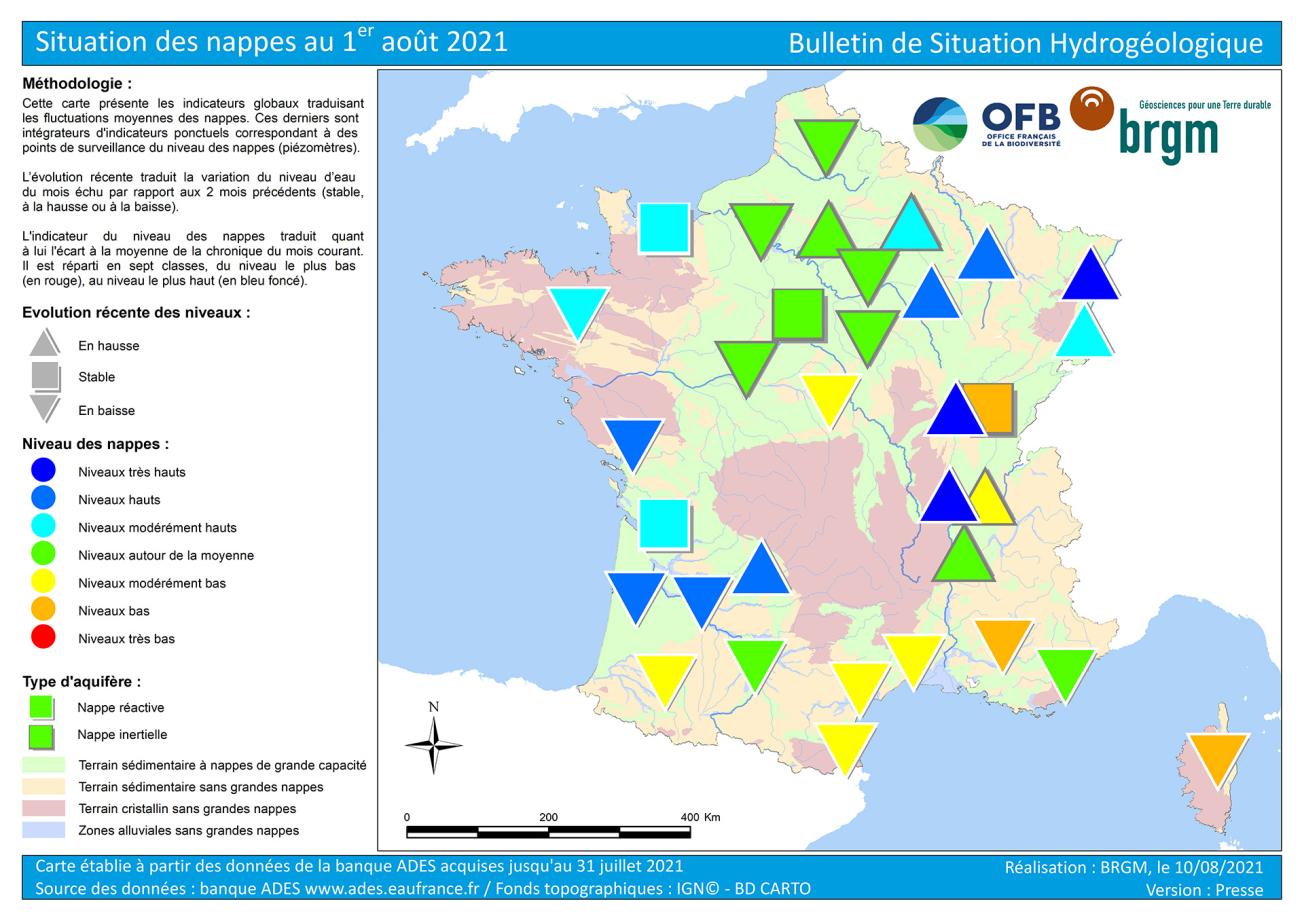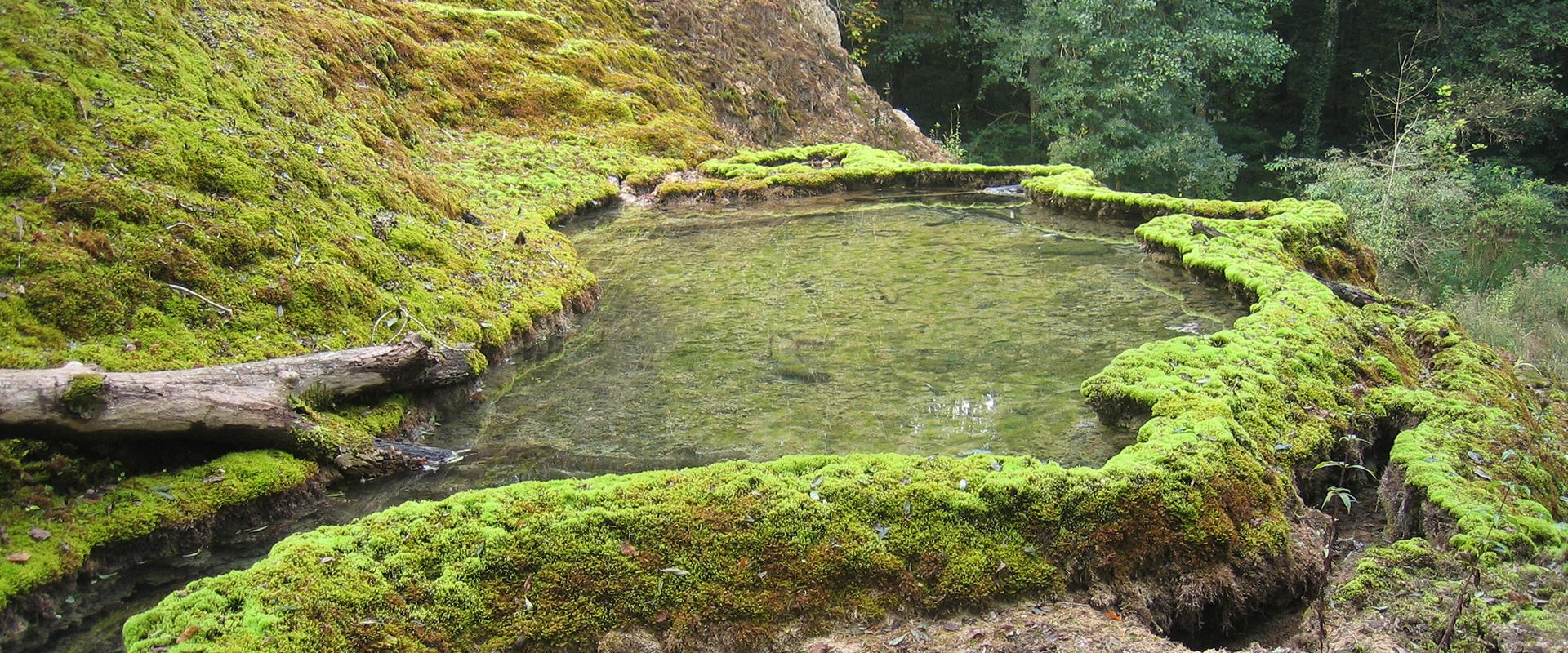
Map of water table levels in France on 1 August 2021.
© BRGM
Hydrogeological situation on 1 August 2021
There were variable trends in July 2021, which is unusual for this time of year. Any summer rainfall that soaks into the ground is taken up by vegetation and rarely replenishes the aquifers. Levels are therefore expected to fall. However, the exceptional rainfall in the summer of 2021 is leading to rising water tables, particularly in the north-eastern third of the country.
Over much of the north-west, the situation in July has been highly satisfactory, with levels above the monthly averages. It is not so satisfactory for the inertial aquifers of the Rhône-Saône corridor and the aquifers around the Mediterranean and Corsica.
Without sufficient rainfall, depletion of the aquifers is expected to resume in August. Levels are expected to remain above or near to normal monthly values over much of the country. The Provence and Corsica aquifers could be a cause for concern.
Trends in groundwater level fluctuation
During the autumn and winter of 2020–2021, most of France experienced substantial groundwater recharge except along the Mediterranean coastline, where replenishment was very low. The groundwater depletion period ended a little earlier than usual, between February and April. A dry start to the spring resulted in unusually large drops in water tables. This situation did not continue.
In general, periods of spring and summer rainfall only infiltrate very slightly into the ground. They moisten the soil and primarily benefit vegetation. Water table depletion was therefore expected to predominate in July. However, the summer of 2021 proved to be atypical: the abundant rainfall between May and July combined with low evapotranspiration slowed down the intensity of depletion and even led to recharging at times.
As a result of heavy rainfall, in July 2021 rising water tables are being observed from the Grand-Est to the Rhône-Alpes aquifers. The exceptional rainfall resulted in sudden but brief rises in the levels of the reactive aquifers in the Jurassic limestone of the Côtes de Bars and Lorraine, the alluvial deposits of the Alsace plain and the alluvial deposits of the Rhône, the Saône and their tributaries. The inertial aquifers of the plio-quaternary formations and the fluvio-glacial corridors of the Rhône and the Saône are responding more slowly to the rainwater that has infiltrated over recent weeks. Their levels rose or remained stable in July, which is a highly unusual trend for this period.
Depletion is continuing in the highly inertial aquifers of the Artois and the Paris Basin. However, the rainfall of the last few weeks has been slowly infiltrating deep into the ground and depletion has slowed down considerably. Some water tables are even showing stable or rising levels. These observations are highly unusual for these water tables at this time.
Aquifer depletion is taking place from the Cotentin Peninsula to the Aquitaine Basin. However, while the levels are mostly falling, the trend is less dominant than in previous months. Some highly reactive water tables are in fact experiencing local stabilisation or rising levels.
Aquifer depletion is taking place on the Mediterranean rim and in Corsica. Periods of local rainfall did little to benefit the aquifers there.
Situation in relation to July averages
In July 2021, water table levels varied from low to very high. The effects of the periods of recharge are being felt and the water table situation has improved since the previous month.
In the east, the abundant rainfall in July fed the reactive near-surface aquifers. The situation has improved considerably, with moderately high to very high levels in the Jurassic limestone aquifers of the Côtes de Bars and Lorraine, in the alluvial aquifers of the Alsace plain and in the aquifers of the Rhône, the Saône and their tributaries. The highest July levels ever measured were recorded in particular in the Meuse basin and on the northern Alsace plain. The inertial aquifers of the plio-quaternary formations of Bourgogne-Franche-Comté and Rhône-Alpes have changed very little because their hydrodynamic behaviour is subject to substantial inertia. Their levels remain below normal monthly values, from moderately low to low.
In the north, in Artois and in the Paris Basin, the aquifer levels in the chalk and tertiary formations are comparable to normal monthly levels. The situation is identical to the previous month, as these inertial water tables are not very sensitive to spring and summer weather and change very slowly.
In the west, on the Cotentin Peninsula, in Brittany and in the Aquitaine Basin, the situation has improved and varies from close to normal monthly levels to high levels. Water tables were lower than normal monthly levels only in the Adour and Gave de Pau alluvial aquifers.
In the south, water tables are variable along the Mediterranean rim and in Corsica, ranging from near normal to low levels. The situation has shown slight local improvement as a result of the rainfall, but remains unsatisfactory.
Several aquifers are in a good condition, with high to very high levels in relation to July levels in previous years:
- The water tables in the alluvial deposits of the upper Rhône, the Saône and its tributaries rose substantially and reached very high levels for certain periods following the heavy rainfall in May, June and July;
- The Jurassic limestone aquifers of the Côtes de Bars and Lorraine and the alluvial deposits of the Alsace plain are at high to very high levels;
- The plio-quaternary alluvial aquifers of the downstream Garonne and the Dordogne and the limestone south of the Vendée and the western Aquitaine Basin have benefited from substantial winter recharge and their levels have been kept high by the rainfall of the last few weeks.
The situation is not as good for some aquifers, with levels below July averages and requiring close monitoring:
- The water tables in the Pliocene gravel of Burgundy-Franche-Comté and of the fluvio-glacial corridors of the upper and middle Rhone are at moderately low to low levels, due to insufficient recharge over several successive winters and to their inertial behaviour;
- The situation remains precarious in the karst aquifers of the Montpellier and Nîmes regions and in the alluvial aquifers and complex formations of the Languedoc coast, Roussillon and Provence, where groundwater levels are moderately low to low;
- The alluvial aquifers of Corsica, where the levels are low, are the only area where the situation is deteriorating in relation to the previous month.
Forecasts
MétéoFrance forecasts that August, September and October will be warmer than normal over the southern two-thirds of France. There is no preferred scenario for the north in terms of temperatures and over the whole country in terms of precipitation.
The rainfall in summer does not usually lead to aquifer recharge. The water that soaks into the ground is usually taken up by vegetation and summer storms result in more runoff and less effective rainwater infiltration. In August, aquifer depletion is expected to resume throughout the country until the vegetation reaches its dormant period and until there are periods of abundant rainfall.
Reactive aquifers, particularly alluvial, basement and Jurassic limestone aquifers, are sensitive to the lack of rain. Trends and changes in the situation will mainly depend on effective local rainfall and on the levels of water use.
Over much of the north of the country, the rainfall between May and July kept the water tables favourable, above normal monthly levels. The benefit of these recharge periods is expected to continue in August and the situation should remain satisfactory.
Along the Mediterranean coast and in Corsica, groundwater levels are highly likely to fall over the next few weeks and the situation could become difficult locally in some aquifers that are subject to high demand.
The inertial aquifers of the Paris Basin and the Rhône valley are not very sensitive to summer rainfall due to their high level of inertia. The effect of the rainwater that has infiltrated in the last few weeks should continue to be felt, but downward trends are expected to resume in August.
The situation is not expected to change, except in areas with high rates of groundwater abstraction. The situation is therefore expected to remain satisfactory, with aquifer levels close to normal monthly values in the chalk and tertiary formations of the Paris Basin. Water tables in the Burgundy-Franche-Comté plio-quaternary gravel and in the fluvio-glacial corridors of the Rhône are expected to remain below normal monthly levels.
Hydrological Status Report
The national hydrological status report consists of a set of maps with corresponding comments that show the monthly evolution of water resources. It describes the quantitative situation of aquatic environments (effective rainfall, river discharge, groundwater table levels, reservoir-dam filling status) and provides summary information on Prefectoral Orders issued to limit water use during the low-water period.







